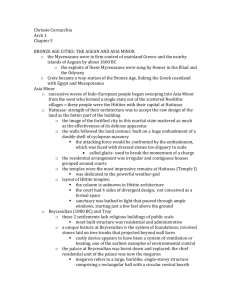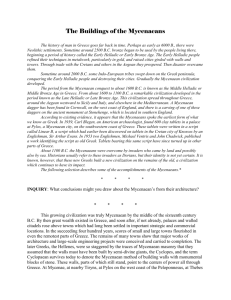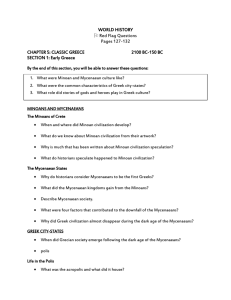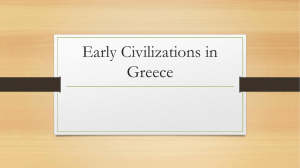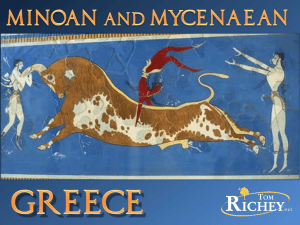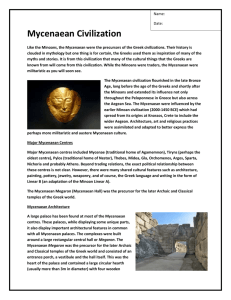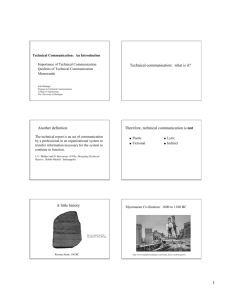Unit_5_files/Mycenaean Art Note
advertisement
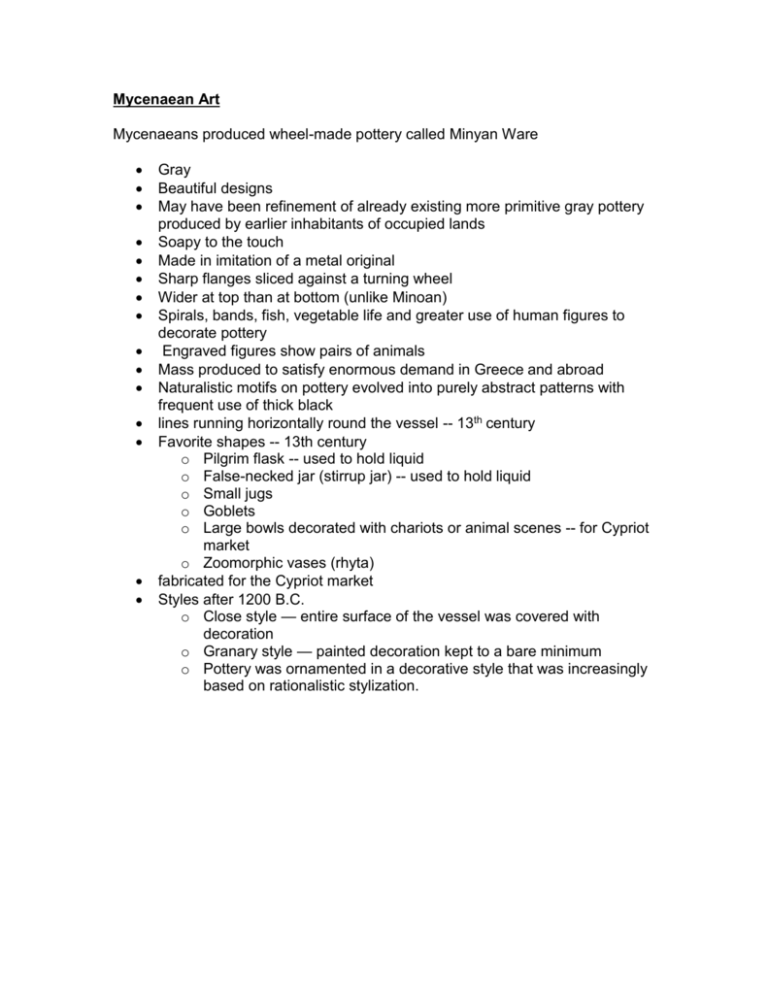
Mycenaean Art Mycenaeans produced wheel-made pottery called Minyan Ware Gray Beautiful designs May have been refinement of already existing more primitive gray pottery produced by earlier inhabitants of occupied lands Soapy to the touch Made in imitation of a metal original Sharp flanges sliced against a turning wheel Wider at top than at bottom (unlike Minoan) Spirals, bands, fish, vegetable life and greater use of human figures to decorate pottery Engraved figures show pairs of animals Mass produced to satisfy enormous demand in Greece and abroad Naturalistic motifs on pottery evolved into purely abstract patterns with frequent use of thick black lines running horizontally round the vessel -- 13th century Favorite shapes -- 13th century o Pilgrim flask -- used to hold liquid o False-necked jar (stirrup jar) -- used to hold liquid o Small jugs o Goblets o Large bowls decorated with chariots or animal scenes -- for Cypriot market o Zoomorphic vases (rhyta) fabricated for the Cypriot market Styles after 1200 B.C. o Close style — entire surface of the vessel was covered with decoration o Granary style — painted decoration kept to a bare minimum o Pottery was ornamented in a decorative style that was increasingly based on rationalistic stylization. Metal work was the Mycenaean’s greatest achievement. Mycenaean Metalworkers made golden artifacts often with engraved gems showing pairs of animals 1. 2. 3. 4. 5. Thin gold cups from Vaphio— slightly south of Sparta Gold death masks Bronze daggers found in shaft graves Bronze shields, swords, spears, armor Scarabs and gold rings — found in tombs Some scenes depicted show obvious Minoan influence Warfare and hunting scenes — uniquely Mycenaean "The most magnificent of the status items were the work of the Mycenaean goldsmiths. A gold cup, an offering vessel in the shape of a lion’s head, gold tiaras and decorative gold discs that were sewn on to women’ dresses like huge sequins, and the extraordinary beaten-gold face masks found in some of the royal graves are the best examples. The masks in particular are intriguing, sine they give… suggestive glimpses of the actual faces of the Mycenaean rulers — the features certainly vary enough to make it likely that these are lifelike portraits; they are certainly not designed to flatter their subjects." Other Mycenaean Art Frescoes such as Boar Hunt at Tiryns The Mycenaeans borrowed the techniques of wall painting, pottery decoration and seal-making from the Minoans. Ivory carving — peaked c. 1400-1200 boxes plaques free-standing groups Mycenaean Art Pottery Small clay figurines "Mycenaean terra cotta figurines are unique and are found in great numbers. The most common type is a female figure ultimately derived from Crete. The figurines seem to have been subjected to the same ruthless stylization as were designs on pottery. The three basic types are named after the letters of the Greek alphabet which they resemble, Phi, Psi, and Tau, with a number of variations. Psi figurines are the earliest type and Tau the latest. Found both in cemeteries and in settlements, the figurines represent standing women dressed conservatively in an overall garment, either in disc-shaped and armless (Phi type) or with their arms extended in a crescent (Psi type). Simply modeled and covered with usually vertical stripes, they have been variously interpreted. Some may represent divine beings while others were perhaps simply dedications. Other types of figurines are also known, including bovine animals, horses and riders, oxen and riders, chariots, and groups including paired female figures similar to the miniature group from Mycenae. "A number of large figurines, considered to be idols by their excavator, Lord William Taylour, were found in Mycenae’s cult area. Seven of the figures are male, ten female, and two apparently hermaphrodites, having characteristics of both sexes. They vary considerably in size, clothing, position of arms, painting, and attitude, from a delicately painted fourteenth century female figurine about 29 centimeters in height to larger, cruder, and fiercer figures some 60 centimeters high. The idols were made on a potter’s wheel, with the arms and sometimes the facial features added separately. Most of the larger figures are painted in simple slashes of black glaze, with areas reserved to emphasize the face. A bust of one of the female figures, 30 centimeters high, shows clearly the power and individuality such idols could attain. The holes in the figure are considered by the excavator to be firing holes, but may also have served to secure decoration to the figure. "Various other objects in terra cotta are of course known from Late Bronze Age contexts throughout the Mediterranean including buttons , spindle whorls, loom weights for use in weaving, and the like." "A typical Mycenaean artifact is the small clay figurine, most often fashioned in the crude shape of a woman but sometimes assuming various animal shapes. Such figures have been found in very large numbers at Mycenaean sites, especially in tombs; they may have served as votives, but their exact purpose is unknown." [Hooker, "The Mycenaeans, p. 212..] Key Differences between Minoans and Mycenaeans a. b. c. d. e. Mycenaeans definitely had a slave system Mycenaeans geared much more toward warfare Heavily fortified settlements Ostentatious tombs for Mycenaean kings — weapons in burials monumental sculpture — Lion Gate
